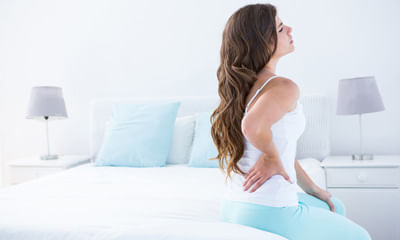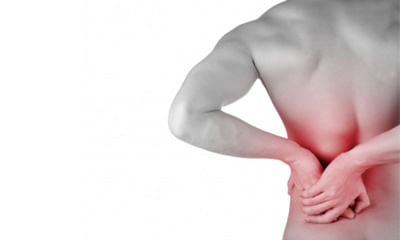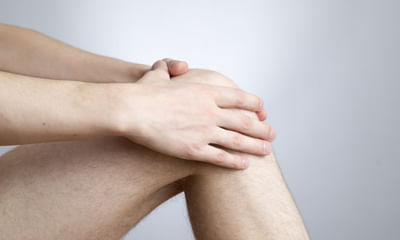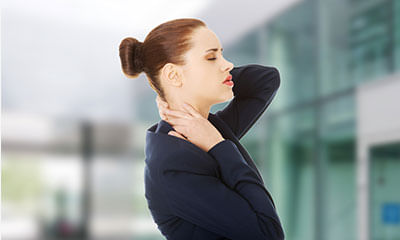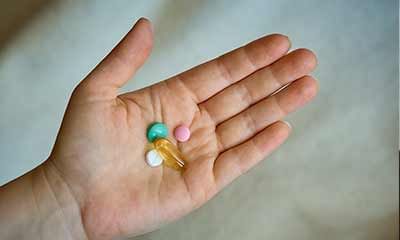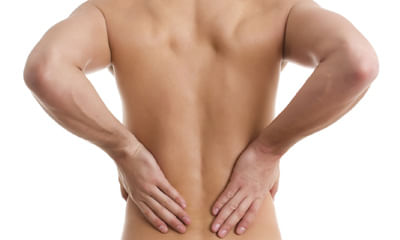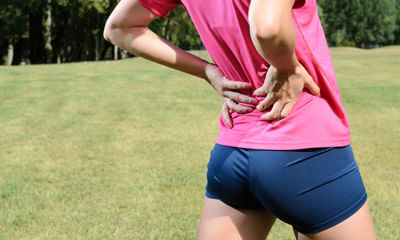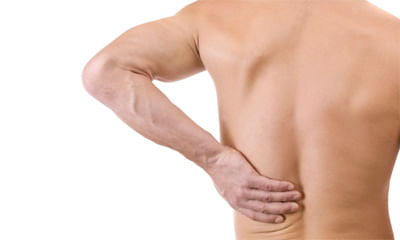Cervical Spine Bulging Disc Symptoms
Hello doctor I have severe left upper back pain, heartburn,swallowing difficulty .pain is radiating to left hand. I cann ...
Ask Free Question
There could be multiple reasons for your pain. It is important to understand whether your pain is arising from neck, thoracic spine, digestive sysmtem (esophageal disorders) or cardiac (heart) cause. Do you have fever, weight loss, appetite issues? Do you have relief in symptoms with gabaneuron? Is disc bulge at c3c4 more on left side? Usually disc bulge at c3c4 shouldnot give rise to pain in left hand. It is more related with disc bulge at c5c6/ c6c7. It is important to have a look on your mri again. Do you have bulge at these levels too. Please consult orthoepdic surgeon (me or anyone of your choice) to rule out pain arising from neck.
Cervical spine nerve disc bulge and compression c5 c6 c7 in neck with chest upper back pain dizziness headache since 4 y ...
Ask Free Question
counslt to physiotherpist. use hard cervical collar.,cerviacl pillow. apply hot pack n anlgesic gel on painful region. tab vertin 8 mg 1 od for 10 days for dizziness. counslt privately for more details.
My mother aged 58 years has been suffering from severe pain in back. It started with pain at single point in upper back ...
Ask Free Question
This is a general low back ache and you can follow these measures: one keep a pillow right under the knee while sleeping, next is you can keep ice in the painful area for about 5--10 minutes, if pain still persists you can stretch your body by twisting the waist on both sides how we used to do in the school drill similarly you can try which will help you relax as well will reduce the pain. It looks like you are is important to check that. Anemia always leads to the symptoms of being tired and also having back / leg pain though there may not be any pathological reasons for back pain. •standing hamstring stretch: place the heel of your injured leg on a stool about 15 inches high. Keep your knee straight. Lean forward, bending at the hips until you feel a mild stretch in the back of your thigh. Make sure you do not roll your shoulders and bend at the waist when doing this or you will stretch your lower back instead of your leg. Hold the stretch for 15 to 30 seconds. Repeat 3 times. •cat and camel: get down on your hands and knees. Let your stomach sag, allowing your back to curve downward. Hold this position for 5 seconds. Then arch your back and hold for 5 seconds. Do 3 sets of 10. •quadruped arm/leg raise: get down on your hands and knees. Tighten your abdominal muscles to stiffen your spine. While keeping your abdominals tight, raise one arm and the opposite leg away from you. Hold this position for 5 seconds. Lower your arm and leg slowly and alternate sides. Do this 10 times on each side pelvic tilt: lie on your back with your knees bent and your feet flat on the floor. Tighten your abdominal muscles and push your lower back into the floor. Hold this position for 5 seconds, then relax. Do 3 sets of 10. •partial curl: lie on your back with your knees bent and your feet flat on the floor. Tighten your stomach muscles. Tuck your chin to your chest. With your hands stretched out in front of you, curl your upper body forward until your shoulders clear the floor. Hold this position for 3 seconds. Don't hold your breath. It helps to breathe out as you lift your shoulders up. Relax. Repeat 10 times. Build to 3 sets of 10. To challenge yourself, clasp your hands behind your head and keep your elbows out to the side. •gluteal stretch: lying on back with both knees bent, rest the ankle of one leg over the knee of your other leg. Grasp the thigh of the bottom leg and pull that knee toward your chest. You will feel a stretch along the buttocks and possibly along the outside of your hip on the top leg. Hold this for 15 to 30 seconds. Repeat 3 times. •extension exercise: lie face down on the floor for 5 minutes. If this hurts too much, lie face down with a pillow under your stomach. This should relieve your leg or back pain. When you can lie on your stomach for 5 minutes without a pillow, then you can continue with the rest of this exercise.
C5-c6 diffuse posterior disc bulge causing thecal sac indentation c6 c7 right para central protrusion intending right ex ...
Ask Free Question
Hi, a person can ease the symptoms of cervical spondylosis/ neck pain with a few simple neck exercises. 1. Neck stretchkeep your body straight. Push your chin forward in a way that stretches the throat. Softly tense the neck muscles. Hold this for 5 seconds.Return your head to its center position. Push your head back with the chin held high, and hold for 5 seconds. Carry out 5 repetitions. 2. Neck tilttilt your head forward so that the chin touches the chest. Softly tense the neck muscles. Hold this for 5 seconds. Return the head to a neutral position. Carry out 5 repetitions. 3. Neck tilt (side-to-side) lean your head down towards either shoulder, leading with the ear. Softly tense the neck muscles. Hold this for 5 seconds. Return your head to the center and repeat on the other shoulder. Carry out 5 repetitions. 4. Neck turn turn your head to one side as far as it remains comfortable, being sure to keep your chin at a level height. Tense your neck muscles for 5 seconds. Return the head to a central position. Repeat on the opposite side. Repeat this exercise 5 times on each side. For this homeopathic treatment is very effective. You can contact me for a detailed consultation.
My mother is 48 years old. She recently had her mri of cervical spine. Following are the features that revealed in the r ...
Ask Free Question
You can do the following exercises for neck pain a person can ease the symptoms of cervical spondylosis/ neck pain with a few simple neck exercises. 1. Neck stretchkeep your body straight. Push your chin forward in a way that stretches the throat. Softly tense the neck muscles. Hold this for 5 seconds. Return your head to its center position. Push your head back with the chin held high, and hold for 5 seconds. Carry out 5 repetitions. 2. Neck tilttilt your head forward so that the chin touches the chest. Softly tense the neck muscles. Hold this for 5 seconds. Return the head to a neutral position. Carry out 5 repetitions. 3. Neck tilt (side-to-side) lean your head down towards either shoulder, leading with the ear. Softly tense the neck muscles. Hold this for 5 seconds. Return your head to the center and repeat on the other shoulder. Carry out 5 repetitions. 4. Neck turn turn your head to one side as far as it remains comfortable, being sure to keep your chin at a level height. Tense your neck muscles for 5 seconds. Return the head to a central position. Repeat on the opposite side. Repeat this exercise 5 times on each side. You can contact me for a detailed consultation.
I had vitamin d3 deficiency which somehow did not get attention from my side for almost 2 years & I have landed up in fe ...
Ask Free Question
You are having multiple small problems in the spine may be secondary to the degenerative changes in the spine. Only thing is you are only 57 years old and the age-related changes seem to be a little premature. What about your blood work? Having these changes in the spine you will have to concentrate on your blood parameters also.
Hi I am 29 years old 5 years back I met with a bike accident, recently I am getting lower back pain. I have undergone mr ...
Ask Free Question
A thorough physical examination reveals much about the patient's health and general fitness. The physical part of the exam includes a review of the patient's medical and family history. Often laboratory tests such as complete blood count and urinalysis are ordered. The physical exam may include: •palpation (exam by touch) determines spinal abnormalities, areas of tenderness, and muscle spasm. •range of motion measures the degree to which a patient can perform movement of flexion, extension, lateral bending, and spinal rotation. •a neurologic evaluation assesses the patient's symptoms including pain, numbness, paresthesias (e.g. Tingling), extremity sensation and motor function, muscle spasm, weakness, and bowel/bladder changes. Particular attention may be given to the extremities. Either a ct scan or mri study may be required if there is evidence of neurologic dysfunction. Physical therapy which teaches the patient to strengthen the paravertebral and abdominal muscles which lend support to the spine. General exercises which help build flexibility, increase range of motion and strength. A corset or a brace could be used to provide support; cervical collars may be used to alleviate pain by restricting movement. Hot or cold packs on the affected area, ultrasound and electric stimulation are some of the other treatments which are used. Management of acute symptoms rest and support- with acute joint symptoms, a lumbar corset may be helpful to provide rest to inflamed facet joints. When acute symptoms decrease, discontinue corset by gradually increasing the time without the corset. Often the most comfortable position is flexion, esp. If there are neurologic signs due to decrease in the foraminal space from joint swelling or osteophytes. Education of posture- head, neck and shoulders should be supported by the back rest of chair with a small pillow in the lumbar spine, the feet supported and the arm resting on arm rests or on a pillow in the lap. Modalities- hot or cold packs on the affected area, ultrasound and electric stimulation are some of the other treatments which are used to decrease pain and reduce muscle spasm. Relaxation- by soft tissue techniques. Teach self relaxation techniques, e.g like deep breathing exercises and physiological relaxation (laura mitchell method) and hydrotherapy. Traction- gentle intermittent joint distraction and gliding techniques may inhibit painful muscle responses and provide synovial fluid movement within the joint for healing. Gentle rom within the limits of pain. Management of subacute and chronic phase increase rom- free active exercises of lumbar spine. Pelvic tilting forward, backward in crook lying, quadriped, sitting and standing. Mobilization- restoration of intersegmental mobility by accessory pressure enables the patient to regain full functional painfree movement. Stretching exercises. Strengthening exercises. Posture correction. I am having a different body shape. My hips are wider than normal male structure which makes my body resemble with a woman's body structure. I want to decrease my hip width. Suggest me ways to deal with this problem. You can go for walking until 5-6 kms which will help you to get reduced with the hip width. It will remove the adipose tissues in the body. There is a bulged out skin from the hole of my hip which is very painful. Can you please help me? Are there any chance to fix facet joint pain from ayurveda. My right hand thumb bone has been dislocated. What should be done? You have to keep ice immediately to reduce the inflammation and you have to immobilize the joint by keeping a plaster. Consult near by orthopaedician to correct the dislocated bone. I have pain in back side of stomach. I have done ultrasound. It was diagnosed stone in gall bladder. What are treatments for removing stone from gall bladder. You can drink hot water and also general lukewarm water to flush out the stone. Apart from that you can take good fibre foods which will definitely help you to get removed from the current symptoms.
Having neck pain vertigo and unsteadiness while walking and standing for 4 months. Had mri of brain and cleverical mri. ...
Ask Free Question
Eye inflammation can be because of dust. Do u have problem in lumbar spines also. Vertigo, dizziness etc are because of CS. U can do the following exercises for neck pain A person can ease the symptoms of cervical spondylosis with a few simple neck exercises. 1. Neck stretch Keep your body straight. Push your chin forward in a way that stretches the throat. Softly tense the neck muscles. Hold this for 5 seconds. Return your head to its center position. Push your head back with the chin held high, and hold for 5 seconds. Carry out 5 repetitions. 2. Neck tilt Tilt your head forward so that the chin touches the chest. Softly tense the neck muscles. Hold this for 5 seconds. Return the head to a neutral position. Carry out 5 repetitions. 3. Neck tilt (side-to-side) Lean your head down towards either shoulder, leading with the ear. Softly tense the neck muscles. Hold this for 5 seconds. Return your head to the center and repeat on the other shoulder. Carry out 5 repetitions. 4. Neck turn Turn your head to one side as far as it remains comfortable, being sure to keep your chin at a level height. Tense your neck muscles for 5 seconds. Return the head to a central position. Repeat on the opposite side. Repeat this exercise 5 times on each side.
I am 50 years old woman I am neck pain and back pain mri result note: disc osteophyte bulge indenting thecal sac and cor ...
Ask Free Question
Neck PainThis is cervical pain (neck pain) and that's the reason the pain radiates until the shoulder blades. If you keep ice that would help and along side you can do hot water fermentation. You shall use cervical collar which would help you to reduce the radiating pain ie. Due to the nerve compression. Cervical spondylosis – chronic condition with radiating pain As your rightly said you have to go for traction and also you can do IFT. Please consult the near by therapist for quick relief. Since you have pain for more than 10 years it is suggestible to go for cervical muscle strengthening exercise. Use collar will definitely be helpful for him to maintain the good posture. And also cervical pillow can be used which might make you to have better posture of the shoulder neck and arm. This is cervical pain (neck pain) and that's the reason the pain radiates until the shoulder blades. If you keep ice that would help and along side you can do hot water fermentation. You shall use cervical collar which would help you to reduce the radiating pain ie. Due to the nerve compression This is a general low back ache and for this you can follow these measures: one keep a pillow right under the knee while sleeping, next is you can keep ice in the painful area for about 5--10 minutes, if pain still persists you can stretch your body by twisting the waist on both sides how we used to do in the school drill similarly you can try which will help you relax as well will reduce the pain. It looks like you are anaemic. If you have back pain after you sit for long hours then it is due to your haemoglobin levels as it is important to check that. Anaemia always leads to the symptoms of being tired and also having back / leg pain though there may not be any pathologicalreasons for back pain. If you have leg pain then you have to rule out the casues for having leg pain. Firstf all check your weight and your haemoglobin levels, as Anaemia always leads to the symptoms of being tired and also having leg pain though there are no issues with the knee joint or back pain. If not if the pain radiates down the back of thigh and legs then it might be due to sciatica. Kindly consult the nearby physiotherapist. Hope you recover soon from the leg pain. Physiotherapy treatment:Ift and swd can be done for localized pain.Ift and traction can be done if you have radiating pain. •Standing hamstring stretch: Place the heel of your injured leg on a stool about 15 inches high. Keep your knee straight. Lean forward, bending at the hips until you feel a mild stretch in the back of your thigh. Make sure you do not roll your shoulders and bend at the waist when doing this or you will stretch your lower back instead of your leg. Hold the stretch for 15 to 30 seconds. Repeat 3 times. •Cat and camel: Get down on your hands and knees. Let your stomach sag, allowing your back to curve downward. Hold this position for 5 seconds. Then arch your back and hold for 5 seconds. Do 3 sets of 10. •Quadruped arm/leg raise: Get down on your hands and knees. Tighten your abdominal muscles to stiffen your spine. While keeping your abdominals tight, raise one arm and the opposite leg away from you. Hold this position for 5 seconds. Lower your arm and leg slowly and alternate sides. Do this 10 times on each side. •Pelvic tilt: Lie on your back with your knees bent and your feet flat on the floor. Tighten your abdominal muscles and push your lower back into the floor. Hold this position for 5 seconds, then relax. Do 3 sets of 10. •Partial curl: Lie on your back with your knees bent and your feet flat on the floor. Tighten your stomach muscles. Tuck your chin to your chest. With your hands stretched out in front of you, curl your upper body forward until your shoulders clear the floor. Hold this position for 3 seconds. Don't hold your breath. It helps to breathe out as you lift your shoulders up. Relax. Repeat 10 times. Build to 3 sets of 10. To challenge yourself, clasp your hands behind your head and keep your elbows out to the side. •Gluteal stretch: Lying on your back with both knees bent, rest the ankle of one leg over the knee of your other leg. Grasp the thigh of the bottom leg and pull that knee toward your chest. You will feel a stretch along the buttocks and possibly along the outside of your hip on the top leg. Hold this for 15 to 30 seconds. Repeat 3 times. •Extension exercise: Lie face down on the floor for 5 minutes. If this hurts too much, lie face down with a pillow under your stomach. This should relieve your leg or back pain. When you can lie on your stomach for 5 minutes without a pillow, then you can continue with the rest of this exercise.
I have cervical and lower back pain since last 10 years Pls tell me which kind of exercises I should do? I will be alway ...
Ask Free Question
Lifestyle Habits: Every morning Do minimum 30 Minutes of Yog: Asana and Pranayam. Add Physical Exercise/Gym and Outdoor sports during evening Hours, in your daily routine. Balanced Diet is also required. Avoid Refined Sugar, Oily fast foods, spices. For good sleep: Avoid using Electronics and Social media after late evening. Medical help: If the problem continues, even after longer duration of Lifestyle habit changes, Do not hesitate to consult a Neurologist for help.

